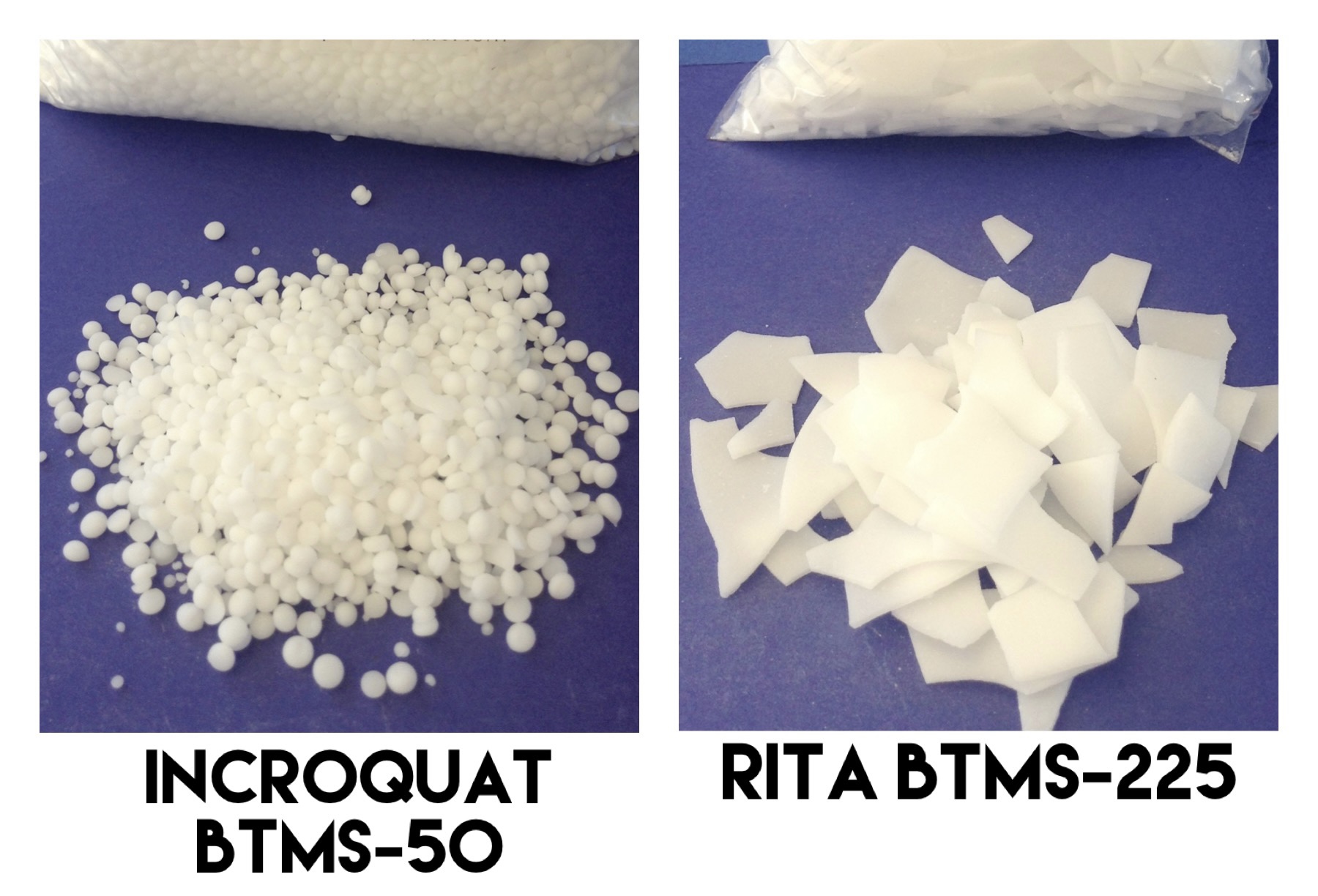So there’s a supplier who is selling what they’re calling Incroquat BTMS-50 (INCI: Behentrimonium methosulfate (and) cetyl alcohol (and) butylene glycol) and people are reporting it’s not working well in all kinds of formulas, leading to harder conditioner bars and failing emulsions. When I asked more questions of those customers, they said it came in a flake format. Let’s take a look at this problem in a little more detail…
Look at the photo above to see the differences between Incroquat BTMS-50 and Rita BTMS-225. I should point out that these are specific versions of these ingredients. You can find BTMS-25 as pellets, but I’ve yet to see BTMS-50 as anything other than pellets or pastilles.
- Using BTMS-25 in emulsions!
- Comparing Cetyl Alcohol & Cetearyl Alcohol!
- Using BTMS-25 instead of BTMS-50 in liquid conditioners
- Related posts for liquid conditioners
- Using BTMS-25 instead of BTMS-50 in a solid conditioner or shaving bar!
- An aside on using BTMS-50 and BTMS-25 together in a conditioner bar!
- Related formulas about conditioner bars!
- A bit of a rant about unscrupulous suppliers!
Incroquat BTMS-50 doesn’t come as a flake format. It only comes in pastilles or these little white pellets. If someone gives you Incroquat BTMS-50 and it doesn’t look like the photo at the top, it isn’t Incroquat BTMS-50.
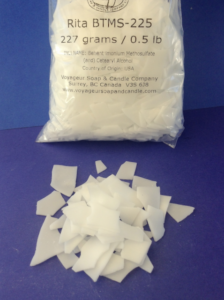
If you receive something like these flakes, this is Rita or Incroquat BTMS-25, which is not a direct substitute for Incroquat BTMS-50 for a few different reasons.
Rita BTMS-225 or Incroquat BTMS-25 (INCI: Behentrimonium Methosulfate (and) Cetearyl Alcohol) is lovely, but it’s only 25% active BTMS compared to BTMS-50’s 50%.
Using BTMS-25 in emulsions!
This will cause a mess in a lotion because it’s not as strong as Incroquat BTMS-50 as an emulsifier because you’re using 50% less BTMS – the emulsifier – less than expected if you substitute BTMS-25 for BTMS-50 1:1. It can lead to less stable emulsions that can experience far more fails, which is a waste of your supplies and time, and really freakin’ frustrating.
If you’d normally use Incroquat BTMS-50 at 6% in a body butter, you’d have 3% behentrimonium methosulfate and 3% Cetyl Alcohol. If you normally use Incroquat BTMS-50 in a lotion at 5%, you’d have 2.5% behentrimonium methosulfate and 2.5% Cetyl Alcohol.
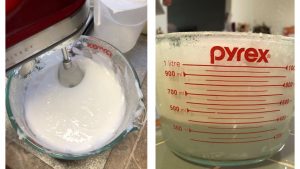
If you use Rita BTMS-225 at 6% in a body butter, you’d have 1.5% behentrimonium methosulfate and 4.5% Cetearyl Alcohol. If you BTMS-25 in a lotion at 5%, you’d have 1.25% behentrimonium methosulfate and 3.75% Cetearyl Alcohol.
As you can see, if you would normally use 6% BTMS-50, you’d have 3% BTMS. If you substituted BTMS-25, you’d have 1.5%, 50% less BTMS than called for in the original formula. This is why you’d experience such a lotion fail.
Related posts: Lotion fails section of the site!
Products made by substituting BTMS-25 for BTMS-50 will result in much thicker emulsions because you have 4.5% structuring agent in the form of cetearyl alcohol rather than 3% Cetyl Alcohol. The lotion will feel more waxy with more greasiness and more drag.
The melting point with the BTMS-25 will be higher because Cetearyl Alcohol has a higher melting point than Cetyl Alcohol.
You can see in the chart that the Cetearyl Alcohol is a larger molecule than Cetyl Alcohol, and larger means more surface tension and higher viscosity, which leads to more feelings of tackiness, greasiness, cushion, waxiness, and drag. It also increases the melting point.
Comparing Cetyl Alcohol & Cetearyl Alcohol!

Using BTMS-25 instead of BTMS-50 in liquid conditioners
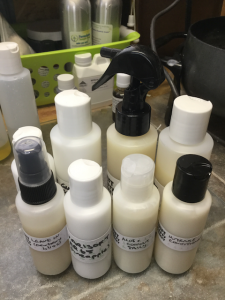
In hair care products, like liquid conditioners, BTMS-25 is less conditioning because you’re using 50% less BTMS than you expected.
If you use 7% BTMS-50 in a conditioner, you’d have 3.5% conditioning ingredient in it.
If you use 7% BTMS-25 in a formula, 1.75% conditioning ingredient, which is a pretty big reduction.
The inclusion of more structuring agent – using 75% in BTMS-25 instead of 50% in the BTMS-50 – in a liquid will make the final conditioner thicker, more draggy, more waxy because you just have more of it.
It might weigh down finer hair because it’s a much thicker product, so I don’t usually suggest it for children’s hair or fine hair or for volumizing products.
Related posts for liquid conditioners
Just some of the latest ones. I have literally hundreds all over the site and in my e-books.
Creating rinse-off conditioners with silicone substitutes: Adding hair care actives to prevent colour fade or retain curls (part eight) – the formula! (end of the series, all the links are in there…)
Creating a moisturizing conditioner for different hair types with ximenia seed oil!
Using BTMS-25 instead of BTMS-50 in a solid conditioner or shaving bar!
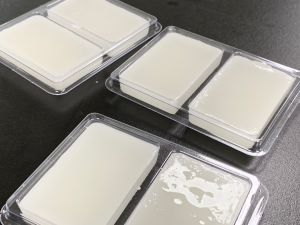
Using this as the primary ingredient for a conditioner bar will create a bar with much more drag, a higher melting point, and 50% less conditioning.
For someone will fine hair, the Cetearyl Alcohol will weigh it down much more than Cetyl Alcohol, and to get the same conditioning you have to use even more of it.
When I’ve used it in shaving bars, it results in a much harder bar that has more drag with a higher melting point. It rinses off nicely, but it takes much more effort to apply and rub on one’s face.
The same applies to in-shower lotion bars.
Related post:
Solid conditioner bar becomes shaving bar.
An aside on using BTMS-50 and BTMS-25 together in a conditioner bar!
There’s absolutely no need to use both BTMS-25 and BTMS-50 in a conditioner bar as they contain the same ingredients. If you wanted to add cetearyl alcohol to a BTMS-50 formula, just buy it on its own as it’s about 75% cheaper!
If we have a formula that’s 60% BTMS-50, we have 30% BTMS and 30% Cetyl Alcohol.
If we have a formula that’s 60% BTMS-25, we have 15% BTMS and 45% Cetearyl Alcohol. (Notice this is half the conditioning in the original formula with 15% more fatty alcohol).
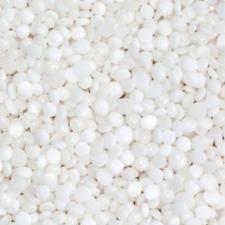
If we made a formula with 30% Incroquat BTMS-50 (15% BTMS and 15% Cetyl Alcohol) and 30% BTMS-25 (7.5% BTMS and 22.5% Cetearyl Alcohol) we’d have 22.5% BTMS-50, 15% Cetyl Alcohol, and 22.5% Cetearyl Alcohol.
This is 7.5% less conditioning than the version with BTMS-50 with more fatty alcohol – a total of 37.5% fatty alcohol.
That’s a lot of fatty alcohol – not a bad thing, but it’s much less conditioning than the original formula and there might be too much for fine or oily hair.
If this is what you want, I’d suggest instead using both, use 60% BTMS-50 to get 30% BTMS, 30% fatty alcohol, and add an additional 7.5% Cetearyl Alcohol for a total of 37.5% fatty alcohol. You’ll make a really solid bar with a higher melting point, if that’s what you want. And it’ll be a lot cheaper than 30 grams of BTMS-25.
For instance, at one supplier BTMS-25 is 5.4¢ a gram, so 30 grams in a 100 gram conditioner bar is $1.62. Cetearyl Alcohol is ¢2.8 per gram, so 7.5 grams in a 100 gram conditioner bar is ¢21. A difference of $1.41 to get the same amount of fatty alcohol in a formula!
Weird, I thought I’d written a post about this as I saw more than a few DIYers sharing my formula for a conditioner bar as their own with this 30% BTMS-50, 30% BTMS-25. I suspect they did it to (a) disguise they’d “borrowed” my work and (b) couldn’t find Incroquat CR, which I used at 30% with 30% BTMS-50 way back in 2009. I guess I didn’t write that post? Consider this that post! 😝
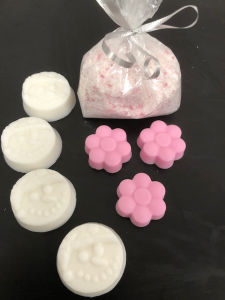 Related formulas about conditioner bars!
Related formulas about conditioner bars!
You can find the master conditioner bar post by clicking this link!
Solid conditioner bar: The formula
Conditioner bars: A visual tutorial
Solid conditioner bar becomes a shaving bar
Melting point for conditioner bars?
Can you see how using BTMS-25 instead of BTMS-50 will alter your formulas? This isn’t necessarily a bad thing -it’s just that a product you made with one could be quite different than made with the other.
A bit of a rant about unscrupulous suppliers!
I’m not sure if this supplier really doesn’t know the difference or doesn’t care: Either way, this is someone with whom I wouldn’t do business. It’s the supplier’s job to know their ingredients and ensure we’re getting what we’ve paid for instead of some random ingredient that could mess up our products. This is why I suggest the suppliers I do – I’ve bought from each of them for years (one for 16+ years) – because I know they know their stuff and they’re super reliable. They can offer all kinds of documentation, and I know they take their own photos and write their own descriptions if they aren’t using the ones from the manufacturers.
This is also why I don’t take sponsorship, have ads or affiliate links, or engage in promoted or sponsored posts. I want you to know that if I suggest an ingredient or equipment, it’s because I have experience with those suppliers and retailers. I can’t imagine suggesting anyone or anything without having a solid track record with them.
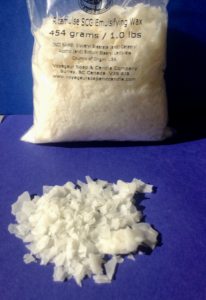
Don’t believe the pictures you’re shown with the ingredients for some suppliers. There’s one out there who has lifted almost all of their photos for all kinds of ingredients from other suppliers, Alibaba, and such. They advertise four different emulsifiers that are not e-wax NF products with photos of e-wax NF from another supplier – who knows of the ongoing thievery, but, sadly, can’t stop it – so none of those four ingredients actually look like the photo, which is not only confusing but incredibly dishonest.
At the supplier in question, they’re using the same photo for both BTMS-50 and BTMS-25, which we know don’t look the same. Their Ritamulse SCG doesn’t look like any I’ve ever seen as it comes in flakes, not pellets.
My general suggestion is that if your supplier’s photos for ingredients aren’t kinda uniform – if they don’t have theme of a specific colour or container, or if you’re sure you saw that on another site – then you might want to ask yourself if this is the supplier you want to trust.
Point of interest: Suppliers also shouldn’t be using formulas from other formulators without express permission in writing, giving them full credit by name, site, and link when that permission is received. Putting something like “preservation by Muriel” and copying an entire post is theft, plain and simple. Pretending you didn’t get the message when you’re told you’ve pilfered something is still thievery. It makes you a bad, unethical person; a terrible, sad formulator who can’t write a basic formula yourself; and a supplier no one should trust. Thus endeth this rant…
Related posts:
Let’s analyze a “terrible recipe” to learn more about formulating: Part four, looking at a final potential formula, analyzing it a little more with information on how to spot terrible recipes and where to find trusted resources – with links to the first four parts of the series.
For the love of all that is good and holy, please don’t make this: Pumpkin spice body butter!
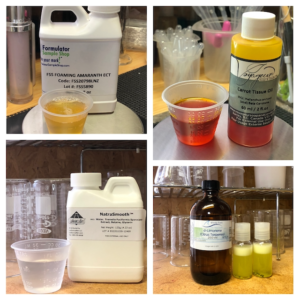
Definitely do a search before shopping at certain suppliers. We have some great suppliers that I can suggest here in North America – Formulator Sample Shop (USA), Lotioncrafter (USA), Voyageur Soap & Candle (Canada), Windy Point Soap Making Supplies (Canada), and more I’ve mentioned on this site – so there’s no need to shop somewhere that doesn’t have a stellar reputation.
Look at things like Trust Pilot for reviews as the terrible ones. Don’t just dismiss the negative reviews as “haters”. There might be the odd person who despises a shop enough to write a bad review here or there, but if you see the same complaints over and over again, it’s unlikely that many people are just “jealous” or “mean”.
There’s one in Canada that has the worst reputation you can imagine, but people keep buying because the prices are lower than everyone else. (Of course they are, they don’t have most of what they’re selling in stock!)
Please share your supplier information in the specific region posts that you can find by clicking here (it’s in the FAQ). Your opinions and experiences are really important for helping others to make good choices.
Where to get supplies in America?
Where to get supplies in Asia?
Where to get supplies in Australia and New Zealand?
Where to get supplies in Canada?
Where to get supplies in Europe?
I share the suppliers I do because I can trust them. I know them as people, as friends, and as dedicated suppliers who work hard to get you all the accurate information they can. Their photos are of the products they have in their shops and they spend their time, money, and energy to make sure the ingredients you see on the page is the one you’re getting.
I’d love to have you share your favourite suppliers in the posts above or in the comments here with explanations of why you like them or what you’ve experienced with them as well as a link or two so we can all find our favourites!

